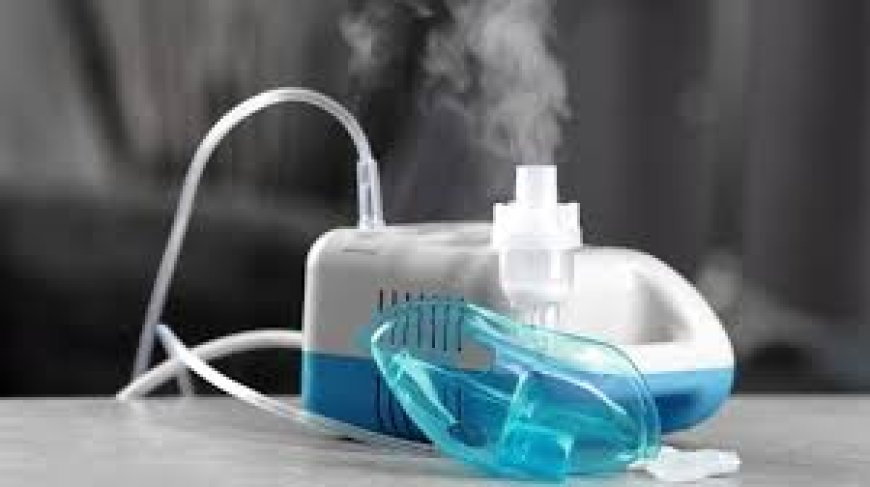How Nebulizers Work: The Science Behind Effective Medication Delivery
About How Nebulizers Work: The Science Behind Effective Medication Delivery

In the world of modern medicine, Nebulizers have emerged as a crucial tool for managing respiratory conditions. From asthma and chronic obstructive pulmonary disease (COPD) to seasonal allergies and bronchitis, Nebulizers provide a direct and efficient way to deliver medication to the lungs.
Among the many brands available, Omron Nebulizers stand out for their innovative technology and reliable performance. In this blog, we’ll explore how Nebulizers work, the benefits they offer, and why they are a vital addition to respiratory care routines.
What Are Nebulizers?
A Nebulizer is a medical device that transforms liquid medication into a fine mist or aerosol, allowing it to be inhaled directly into the lungs.
This method of drug delivery bypasses the digestive system and ensures fast, effective relief from respiratory issues.
Nebulizers are particularly useful for individuals who have difficulty using inhalers, such as young children, the elderly, or patients experiencing severe respiratory distress.
The Types of Nebulizers
Before diving into how Nebulizers work, it’s essential to understand the two primary types of Nebulizers:
Jet Nebulizers
They operate by using compressed air, converting liquid medication into an aerosol.
They are commonly used in hospitals and at home due to their affordability and effectiveness.
Ultrasonic Nebulizers
Makes use of high-frequency sound waves to produce mist from liquid medication.
Quieter and more portable than jet Nebulizers, but not suitable for all types of medication.
How Do Nebulizers Work?
The process of nebulisation involves several stages, all designed to ensure that the medication reaches the lungs efficiently. Here’s a step-by-step breakdown:
Medication Preparation:
The process begins with liquid medication placed in the Nebulizer’s medication cup. This medication could include bronchodilators, corticosteroids, saline solutions, or a combination tailored to the patient’s condition.
Air or Ultrasonic Vibrations:
Depending on the Nebulizer type, compressed air (in jet Nebulizers) or ultrasonic vibrations (in ultrasonic Nebulizers) are used to break the liquid medication into tiny aerosol particles.
Atomisation:
The liquid passes through a small orifice at high speed, transforming it into a mist of microscopic droplets. This atomisation ensures that the medication is dispersed evenly.
Inhalation:
The aerosol is delivered to the patient through a mask or mouthpiece. As the patient breathes in, the mist enters the lungs and begins its therapeutic action.
The Science Behind Nebulizers
Nebulizers work on a simple yet powerful principle: delivering medication in the form of tiny droplets that can penetrate the respiratory system.
Particle Size Matters: The particles produced by Nebulizers must be between 1 to 5 microns in diameter.
Particles larger than this settle in the upper respiratory tract and do not reach the lungs.
Smaller particles risk being exhaled before absorption.
Advantages of Nebulizers
Nebulizers offer several benefits over traditional methods of medication delivery, making them indispensable for respiratory care.
Immediate Relief
Nebulizers deliver medication directly to the lungs, providing rapid relief during asthma attacks or other respiratory emergencies.
Ease of Use
Unlike inhalers, which require precise timing and technique, Nebulizers are simple to operate. This makes them ideal for children, elderly patients, and individuals with limited motor skills.
Customisable Treatment
Nebulizers can be used for a wide range of medications, including saline solutions, antibiotics, and bronchodilators.
Consistency
Devices like Omron Nebulizers ensure consistent mist production, guaranteeing that every breath delivers the right dose of medication.
Quiet Operation
Modern Nebulizers, especially ultrasonic models, are quieter than older versions, making treatment more comfortable for patients.
Why Choose Omron Nebulizers?
When it comes to Nebulizers, not all devices are created equal. Here’s why Omron Nebulizers are a trusted choice among healthcare professionals and patients alike:
Advanced Technology
Omron Nebulizers are equipped with cutting-edge technology to ensure efficient medication delivery. Their devices are designed to produce consistent, fine aerosol particles, maximising therapeutic benefits.
User-Friendly Design
Omron’s devices are intuitive and easy to operate, with features like one-touch operation and lightweight construction.
Portability
Many Omron Nebulizers are compact and portable, allowing patients to continue their treatment regimen while travelling.
Durability and Safety
Built from high-quality materials, Omron Nebulizers are durable and safe for long-term use.
Common Respiratory Conditions Treated with Nebulizers
Nebulizers, including those from Omron, are used to manage a range of respiratory conditions:
Asthma
Nebulizers deliver bronchodilators and corticosteroids directly to the airways, reducing inflammation and opening up the lungs for easier breathing.
Chronic Obstructive Pulmonary Disease (COPD)
For patients with COPD, Nebulizers provide a reliable way to administer medication, easing symptoms and improving quality of life.
Bronchitis
Nebulizers help soothe inflamed airways and deliver medication to combat infection.
Allergies
Nebulizers can be used to administer antihistamines and other medications to relieve allergic reactions.
Cystic Fibrosis
Inhaled antibiotics delivered via Nebulizers help manage infections associated with this condition.
How to Use a Nebulizer
Using a Nebulizer is straightforward, but it’s essential to follow the correct steps for effective treatment:
Set Up the Device: Assemble the Nebulizer according to the manufacturer’s instructions and add the prescribed medication to the medication cup.
Connect the Mask or Mouthpiece: Attach the mask or mouthpiece to the Nebulizer.
Turn On the Nebulizer: Start the device and ensure that it is producing a consistent mist.
Inhale the Medication: Breathe in the mist slowly and deeply until all the medication has been delivered.
Clean the Device: After each use, clean the Nebulizer components to prevent bacterial growth.
Nebulizers vs. Inhalers: Which is Better?
While both Nebulizers and inhalers are used to deliver medication to the lungs, they serve different purposes.
Nebulizers are ideal for patients who cannot use inhalers due to age, severe symptoms, or lack of coordination.
Inhalers are more portable and convenient for mild or moderate conditions.
For severe respiratory conditions or young children, Nebulizers, such as those offered by Omron, are often the preferred choice.
Maintaining Your Nebulizer
Proper maintenance is crucial to ensure your Nebulizer continues to function effectively:
Regular Cleaning: Clean the medication cup, mask, and tubing after each use to prevent bacterial growth.
Replacement of Parts: Replace filters and tubing as recommended by the manufacturer.
Storage: Make sure that the Nebulizer is stored in a cool, dry place to prevent damage.
Conclusion
Nebulizers are a cornerstone of respiratory care, offering an effective and reliable way to deliver medication directly to the lungs. Their ability to provide fast relief, coupled with their ease of use, makes them indispensable for managing conditions like asthma, COPD, and bronchitis. Among the many options available, Omron Nebulizers stand out for their technology, user-friendly design, and proven reliability.
Whether you’re looking for a Nebulizer for home use or a portable device for on-the-go treatment, Omron has a solution to meet your needs. By investing in a quality Nebulizer, you can take control of your respiratory health and breathe easier, knowing you have a trusted tool by your side.
What's Your Reaction?


























